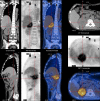A rare case of watery diarrhea, hypokalemia and achlorhydria syndrome caused by pheochromocytoma
- PMID: 25081061
- PMCID: PMC4122777
- DOI: 10.1186/1471-2407-14-553
A rare case of watery diarrhea, hypokalemia and achlorhydria syndrome caused by pheochromocytoma
Abstract
Background: A rare syndrome of watery diarrhea, hypokalemia and achlorhydria (WDHA) is usually caused by pancreatic endocrine tumors that secrete excessive vasoactive intestinal polypeptide (VIP). Here we report a rare case of WDHA caused by a pheochromocytoma.
Case presentation: A 45-year old male presented with persistent and progressive watery diarrhea for half a year, and was treated with dialysis due to azotemia, hypokalemia, hypercalcemia and metabolic acidosis. A right adrenal mass was found by ultrasonography, and Positron Emission Tomography-Computed Tomography (PET-CT) showed the tumor was hyper-metabolic. Levels of plasma normetanephrine (NMN) and serum chromogranin A (CgA) were significantly elevated. Immunohistochemistry analysis of the adrenal tumor was strongly positive for CgA, synaptophysin and VIP. The patient fully recovered from WDHA syndrome soon after surgery, as reflected in that diarrhea stopped, levels of plasma NMN, serum CgA, and electrolytes returned to normal thus no dialysis was needed. The patient remained disease free in a 12-months follow-up period.
Conclusion: We report an extremely rare case of pheochromocytoma causing WDHA syndrome and uremia, which the patient completely recovered from after tumor resection.
Figures


References
-
- Fisher BM, MacPhee GJ, Davies DL, McPherson SG, Brown IL, Goldberg A. A case of watery diarrhoea syndrome due to an adrenal phaeochromocytoma secreting vasoactive intestinal polypeptide with coincidental autoimmune thyroid disease. Acta Endocrinol (Copenh) 1987;114(3):340–344. - PubMed
Pre-publication history
-
- The pre-publication history for this paper can be accessed here:http://www.biomedcentral.com/1471-2407/14/553/prepub
Publication types
MeSH terms
LinkOut - more resources
Full Text Sources
Other Literature Sources
Medical
Research Materials

